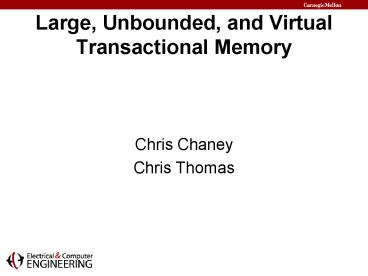Large, Unbounded, and Virtual Transactional Memory - PowerPoint PPT Presentation
1 / 15
Title: Large, Unbounded, and Virtual Transactional Memory
1
Large, Unbounded, and Virtual Transactional Memory
- Chris Chaney
- Chris Thomas
2
Motivation
- Locks have lots of downsides
- We all know them by now
- Software transactional memory is slow
- Architectural limits on transaction size are bad
- Time, space, etc.
3
LTM
- Common case handle by some other hardware
transactional memory proposal - Adds extra support to handle cache overflows
(with OS support) - Supports transactions up to size of physical
memory - No nested transactions
4
LTM
5
LTM Hardware Modifications
- Two extra bits in cache tags
- Overflow base register added to architectural
state - Existing cache coherence protocols handle
conflict detection
6
LTM - Performance
- Microbenchmark simulated on multiprocessor
simulator - Transactions demonstrated much better scalability
- SPECjvm98 simulated on uniprocessor simulator
- Showed that very little time was spent in
overflow - Transaction performance measurement is odd, given
single-threaded machine - Other trace-based analysis showed 99.9 of
transactions used lt54 cache lines
7
UTM
- Common case still some other fast hardware scheme
- Still requires OS support
- Supports transactions up to almost virtual memory
size - Transcations can switch processors, and can run
over multiple timeslices - Still no nested transactions
8
UTM
- Rolls back processor state on abort
- Memory state maintained via xstate data
structure - a log per transaction
- transaction log contains old values of memory
locations - transactional load/stores to each memory block
form a linked list (i.e. one list per memory
block) - requires a pointer per memory block
- gets messy (and slow) when you have
non-transactional memory operations too
9
UTM - xstate
10
UTM Hardware Modifications Performance
- Requires saving register state
- Doesn't provide explanation that works with
context switches though - Regular transactional memory implementation
- Was not benchmarked
- Performance similar to LTM because common case is
still in hardware
11
VTM
- Like UTM/LTM, common case is fast hardware
implementation - Requires OS support
- Supports transactions up to virtual memory size
- Transactions can switch processors and survive
multiple timeslices - No nested transactions
12
VTM
13
VTM
- Memory state managed with XADT
- Transaction Address Data Table
- XADT holds overflowed speculative data, and
access information - When data is in cache, don't need to interact
with XADT - After overflow or on cache miss, need to check
XADT for conflicts - XF (Transaction Filter) is a performance
enhancement
14
VTM - XADT
15
VTM
- Non-T accesses may mess with data
- If running, cache coherence alerts transactions
- If swapped out, VTM has to check state on resume
- On context switch, transaction data is forcibly
flushed - When a transaction is in the commit phase,
non-transactional ops have to check XADT

